#India Battery Market
Text
India Battery Market: Surge in Consumer Electronics Sales to Drive Growth

India Battery Market is expected to grow owing to surge in the sales of consumer electronics, such as smartphones, laptops, and tablets throughout the forecast period.
According to TechSci Research report, “India Battery Market – By Region, Competition, Forecast and Opportunities, 2019-2029”, India Battery Market is expected to register robust growth during the forecast period. Growing concerns about air pollution and climate change have led to increased interest in eco-friendly transportation options. Electric vehicles are viewed as a cleaner and more sustainable alternative to traditional internal combustion engine vehicles. Battery-powered EVs help reduce greenhouse gas emissions and dependence on fossil fuels.
EVs are gaining momentum in India as a sustainable and eco-friendly mode of transportation. This trend presents a significant opportunity for battery manufacturers to meet the growing demand for lithium-ion batteries, which are the primary power source for EVs. Battery manufacturing for EVs and EV charging infrastructure development is a burgeoning market. Opportunities exist for investments in charging station networks, battery assembly facilities, and research and development to improve battery technology.
Based on type, the Lead Acid segment is expected to dominate the market during the forecast period. Lead-acid batteries are used in off-grid and backup power systems in rural and remote areas where there is no access to the main power grid. As India continues to expand its renewable energy infrastructure, lead-acid batteries play a role in energy storage for solar and wind power systems. The Indian government has been promoting clean energy and electric mobility, which could influence the battery market. Policies, incentives, and regulations may encourage the adoption of newer and more sustainable battery technologies. The future of the lead-acid battery segment in the India battery market may depend on factors like technological advancements, environmental regulations, and evolving consumer preferences. Manufacturers may also explore innovations in lead-acid battery technology to make them more competitive and environmentally friendly.
Browse over XX market data Figures spread through XX Pages and an in-depth TOC on the "India Battery Market."
https://www.techsciresearch.com/report/india-battery-market/10563.html
Based on application, the Commercial segment is projected to dominate the market throughout the forecast period. Various businesses and organizations use batteries in UPS systems to safeguard critical equipment, such as computers, servers, and medical devices, from power disruptions and voltage fluctuations. In commercial warehouses and logistics centers, batteries power electric forklifts and other material handling equipment. Lead-acid batteries are commonly used for these applications. Batteries are essential for commercial electric vehicles, such as electric buses and delivery vans. This segment is witnessing growth as companies focus on sustainable transportation solutions.
The need for reliable power supply is a significant driver for the commercial battery market. Battery systems are crucial for ensuring uninterrupted operations in data centers, hospitals, and critical infrastructure facilities. Many commercial establishments are investing in energy-efficient technologies and practices. Batteries play a role in optimizing energy usage, reducing peak power consumption, and managing energy costs. As businesses and institutions seek to achieve energy sustainability and reduce their reliance on grid power, there is potential for the development of microgrids powered by battery systems.
The demand for advanced battery technologies, especially lithium-ion batteries, is expected to increase as businesses and institutions prioritize performance, energy efficiency, and reliability. In summary, the commercial segment of the Indian battery market is a dynamic and evolving space, with a shift towards advanced battery technologies, renewable energy integration, and a focus on sustainability. The commercial sector offers ample opportunities for battery manufacturers and service providers to meet the growing demand for reliable and energy-efficient power solutions in various applications and industries.
Key market players in the India Battery Market are:
Exide Industries Limited
Amara Raja Batteries Ltd
Tata AutoComp Systems Limited
Luminous Power Technologies
HBL Power Systems Limited
Livguard Energy Technologies
Okaya Power Group
Base Corporation Limited
Southern Batteries Pvt. Ltd
Su-Kam Power Systems Ltd
Download Free Sample Report
https://www.techsciresearch.com/sample-report.aspx?cid=10563
Customers can also request for 10% free customization on this report.
“The India Battery Market in South India is poised to be the dominant force in the industry. South India is known for its high penetration of two-wheelers, particularly in states like Tamil Nadu and Karnataka. This leads to a robust market for automotive batteries, including lead-acid batteries. The region is witnessing a surge in electric vehicle adoption, particularly electric scooters and rickshaws. This trend is driving demand for lithium-ion batteries in the electric vehicle segment.” said Mr. Karan Chechi, Research Director with TechSci Research, a research-based global management consulting firm.
“India Battery Market Segmented By Type (Lead Acid, Lithium Ion, Nickel Metal Hydride and Others), By Application (Residential, Industrial and Commercial), By Power Systems (Fuel Cell Batteries, Proton-Exchange Membrane Fuel Cells, Alkaline Fuel Cells and Others), By Region, and By Competition, 2019-2029,” has evaluated the future growth potential of India Battery Marketand provides statistics & information on market size, structure, and future market growth. The report intends to provide cutting-edge market intelligence and help decision makers take sound investment decisions. Besides the report also identifies and analyzes the emerging trends along with essential drivers, challenges, and opportunities in India Battery Market.
Browse Related Research
India Instrument Transformers Market
https://www.techsciresearch.com/report/india-instrument-transformers-market/1979.html
India Wind Turbine Market
https://www.techsciresearch.com/report/india-wind-turbine-market/15204.html
India Solar Inverter Market
https://www.techsciresearch.com/report/india-solar-inverter-market/15193.html
Contact Us-
TechSci Research LLC
420 Lexington Avenue, Suite 300,
New York, United States- 10170
M: +13322586602
Email: [email protected]
Website: www.techsciresearch.com
#India Battery Market#India Battery Market Size#India Battery Market Share#India Battery Market Trends#India Battery Market Growth
0 notes
Text
The India Battery Market is growing at a CAGR of 10.56% over the next 5 years. Exide Industries Ltd , Luminous Power Technologies Pvt. Ltd. , HBL Power Systems Ltd, TATA AutoComp GY Batteries Pvt. Ltd. , Okaya Power Pvt. Ltd. are the major companies operating in India Battery Market.
#India Battery Market#India Battery Market Size#India Battery Market Share#India Battery Market Analysis#India Battery Market Trends#India Battery Market Report#India Battery Market Research#India Battery Industry#India Battery Industry Report
0 notes
Text

E Rickshaw Loader: Affordable and Efficient Solutions
Looking for an eco-friendly and cost-effective transportation solution? The e rickshaw loader is the answer. These versatile vehicles have revolutionized urban logistics with their affordability and efficiency. Understanding the e rickshaw loader price is crucial for businesses and individuals seeking to invest in this sustainable technology.
The e rickshaw loader price varies depending on several factors, including the features and battery capacity. Basic models are more affordable, while premium versions with extended battery life and advanced features might cost more. Despite the initial investment, the low running and maintenance costs make e rickshaw loaders a smart choice.
Additionally, government incentives and subsidies for electric vehicles can significantly reduce the e rickshaw loader price, making them even more accessible. These incentives aim to promote green transportation and reduce urban pollution, aligning with global sustainability goals.
Investing in an e rickshaw loader not only supports environmental conservation but also offers practical benefits like reduced fuel costs and lower maintenance expenses. As cities continue to embrace green technology, the demand for e rickshaw loaders is expected to rise, making now the perfect time to understand and leverage the best e rickshaw loader options.
#E Rickshaw Loader#E Rickshaw Loader Price#E Rickshaw Price in India#Electric Rickshaw Loader#Eco-friendly Transportation India#Affordable E Rickshaw#E Rickshaw Subsidies India#Green Transportation India#Urban Logistics Solutions#Cost-effective E Rickshaw#Low Maintenance E Rickshaw#Electric Vehicle Incentives India#Sustainable Transport India#E Rickshaw Battery Capacity#Urban Pollution Reduction#Electric Cargo Vehicles India#Indian E Rickshaw Market#E Rickshaw Loader Investment#Government Subsidies Electric Vehicles#Green Technology India
2 notes
·
View notes
Text
Is India's Electric Vehicle Manufacturing Ecosystem Ready to Scale up Mass Adoption?
India is on the brink of a major shift in its automotive industry. Driven by the global and domestic push towards electric vehicles (EVs), the country’s EV manufacturing ecosystem is showing promise and ambitious growth projections. It shows a clear commitment to sustainable mobility. However, the road to mass adoption is fraught with challenges that need to be addressed if India is to fully capitalize on this opportunity.

Promising Growth Projections
The potential for growth in India’s EV market is enormous. By 2030, EVs could account for over 40 percent of the automotive market, generating a staggering USD 100 billion in revenue. The penetration rates are particularly impressive for two and three-wheelers, where EVs are expected to make up 80 percent of the market. Even for four-wheelers, the projection is significant, with a 50 percent market share anticipated by 2030. These numbers underscore the growing acceptance of EVs in India and the opportunity for the country to become a global leader in sustainable transportation.
Challenges Hindering Scalability
Despite the promising outlook, several hurdles stand in the way of scaling up EV manufacturing to meet mass adoption. These challenges must be addressed if India’s EV ecosystem is to realize its full potential.
High Ownership Costs: One of the most significant barriers to mass adoption is the high cost of owning an EV in India. This is primarily due to the limited charging infrastructure, which makes it difficult for consumers to rely on EVs for their daily commute. Additionally, there are deficits in battery cell production (20-25 percent) and semiconductor chips (40-50 percent), both of which are critical components for EV manufacturing. These shortages drive up the costs, making EVs less accessible to the average consumer.
Import Dependency: India’s reliance on imports for key EV components is another major challenge. Currently, 60-70 percent of battery cells, e-motor magnets, and electronics are sourced from China. Several lithium-ion battery manufacturing equipment suppliers in India are dependent on the import of cells and assembly equipment. This dependency not only creates supply chain vulnerabilities but also raises concerns about the sustainability of scaling up EV manufacturing. To reduce this reliance, India needs to invest in building local capacities for producing these critical components.
Scalability Issues in Local Manufacturing: While there are efforts to boost local manufacturing, many small enterprises in India are struggling to keep up with the growing demand for EV components. These scalability issues are exacerbated by a fragmented supply chain, where small and medium enterprises (SMEs) face coordination challenges that can lead to delays in production and distribution. This fragmentation hinders the efficiency of the entire EV ecosystem.
Lack of Standardization: Another significant challenge is the lack of standardization in EV manufacturing, particularly in battery specifications. This lack of uniformity complicates component sourcing and integration, making it difficult for manufacturers to scale up production quickly and efficiently. Standardization is crucial for streamlining the manufacturing process and ensuring that components are interchangeable and easily available.
Conclusion
India’s EV manufacturing ecosystem is at a critical juncture. While the growth potential is immense, several challenges must be addressed to scale up production and achieve mass adoption. By focusing on local manufacturing, expanding infrastructure, standardizing components, and supporting SMEs, India can overcome these hurdles and position itself as a global leader in electric mobility. The journey ahead is challenging, but with the right strategies and collaborations, India’s EV revolution is not just possible—it’s inevitable.
#India electric vehicle industry#EV manufacturing in India#Electric vehicle adoption in India#India's EV market growth#Sustainable transportation in India#EV infrastructure in India#Electric vehicle policy India#Mass adoption of EVs in India#Challenges in EV manufacturing#Future of electric vehicles in India#lithium-ion battery manufacturing equipment suppliers in India
0 notes
Text
0 notes
Text
#India battery recycling market size#India battery recycling market share#India battery recycling market trends#India battery recycling market growth
0 notes
Text
What is the Cost of EV Charging Stations in India?
The emergence of small-format mobility, which encompasses electric two- and three-wheelers, is one of the most intriguing developments concerning the expansion of electric vehicles in India. Together, e-2W and e-3W account for 95% of all EVs in the nation. Low- to middle-class consumers, as well as fleet aggregators like Zepto, Blink it, Zomato, Ola, Uber, and others that deal with last-mile deliveries and bike taxis, account for a large portion of the demand for e-2Ws. Riders of the e-3Ws are known to have high demand for the e-rickshaws because of their affordability. Additionally, with the expansion of e-commerce choices, home delivery of bulk orders, etc.

#Electric Vehicle Market#India EV Growth#Electric Vehicle#EV Vehicles#EV Car#Battery Car#EV Charging#Electric Vehicle Charging Stations#EV Cars In India#EV Charging Stations Cost#Electric Automobiles
0 notes
Text
Buy Battery Powered Led Light Bow Tie

Buy Battery Powered Led Light Bow Tie. Illuminate Your Style with Our Radiant LED Bow Ties. Experience Vibrant Lighting and Captivating Visuals.
#india#party gadget#bollywoodedit#investing#indian cinema#led baseball cap#poetry#marketing#attitude#books#Led Light Bow Tie#Battery Powered Led#Tie#hat#watch#jacket#belt#Battery Powered Led Light Bow Tie
0 notes
Text
How Many Electric Car Brands Are There in 2024?
The electric vehicle (EV) revolution has accelerated rapidly in recent years, transforming the automotive landscape. With growing environmental concerns and advancements in technology, 2024 marks a significant year for the proliferation of electric car brands. Understanding the current landscape of these brands is crucial as they play a pivotal role in shaping the future of…

View On WordPress
#2024 trends#ADAS#affordability#Arrival#autonomous driving#battery technology#BMW#Brazil#BYD#car sharing#charging infrastructure#consumer trends#diverse vehicle options#eco-friendly materials#economic growth#electric mobility#electric vehicles#emerging markets#emission reductions#EV Market#fast charging#Ford#Government Incentives#green manufacturing#India#Infotainment#innovation#international collaboration#Lucid Motors#NIO
1 note
·
View note
Text
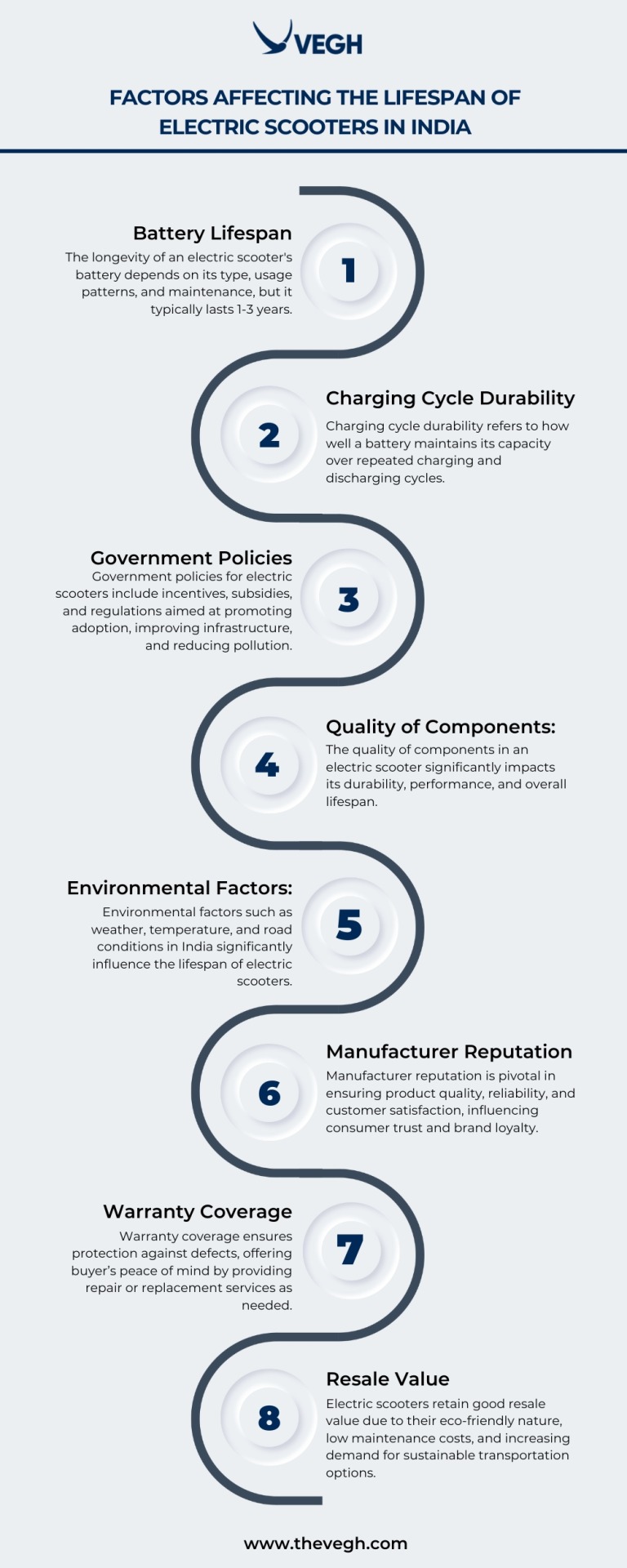
Discover the key factors that impact the lifespan of electric scooters in India and make informed decisions for your business or personal use. Our team of experts with years of experience in marketing will provide valuable insights to help you choose a cost-effective and durable option for long-term sustainability.
#Electric Scooter Life Span#India Market Insights#Vegh Automobiles#electric scooters#EV scooter#E scooter#battery ev scooter
0 notes
Text
#India Electric Vehicle Battery Market Report#India Electric Vehicle Battery Market#India Electric Vehicle Battery#India Electric Vehicle#Electric Vehicle Battery Market Report#Electric Vehicle Battery
0 notes
Text
Investment Opportunities in India: International Battery Company's $1 Billion Investment in Karnataka

India, known for its diverse culture, rich history, and bustling economy, has recently caught the attention of global investors for its thriving business environment. Among the prominent players taking advantage of the investment opportunities in India is the International Battery Company (IBC). In a groundbreaking move, IBC has committed to investing a staggering $1 billion in India's southern state of Karnataka to establish a state-of-the-art factory for the production of lithium-ion cells. This blog explores the significance of this investment, the potential benefits it brings to the region, and the positive impact on the country's electric vehicle industry.
In recent years, India has emerged as a major player in the global economic landscape, presenting lucrative investment opportunities across various sectors. The country's robust economic growth, rapidly expanding middle class, and government policies aimed at promoting foreign direct investment have made it a preferred destination for international companies seeking to tap into the vast market potential. The partnership between IBC and Karnataka is yet another testament to India's growing prominence on the global investment stage.The International Battery Company's decision to invest $1 billion in Karnataka's burgeoning economy marks a significant milestone for the state and the nation at large. As a privately owned company, IBC already manufactures prismatic or rectangular cells in South Korea and aims to expand its operations in India to meet the surging demand for lithium-ion batteries, particularly in the electric vehicle sector. IBC's choice of Karnataka is not arbitrary; the decision was influenced by the state's thriving technology hub, Bangalore. Often referred to as the "Silicon Valley of India," Bangalore houses numerous multinational corporations, research institutions, and tech startups, making it an ideal location for IBC's factory. The proximity to a skilled workforce and a well-established ecosystem for innovation will play a pivotal role in the company's success. India's electric vehicle industry has been gaining traction in recent years, driven by increasing environmental consciousness, government incentives, and a growing need for sustainable transportation solutions. IBC's investment in lithium-ion battery production is set to bolster the domestic electric vehicle market significantly. With the state-of-the-art factory's capacity ramping up to 10 gigawatts by 2028, it is expected to become a crucial supplier of prismatic batteries, helping automakers cut expenses due to their dense packing. The infusion of $1 billion into Karnataka's economy by IBC is expected to have a cascading effect on various sectors. The construction of the factory alone will create a significant number of jobs, providing employment opportunities for local communities and skilled professionals. As the factory becomes operational, ancillary industries, such as transportation, logistics, and manufacturing, will also benefit from the increased economic activity. Recognizing the potential impact of such large-scale investments, the Karnataka government is offering financial incentives to IBC. By providing these incentives post-production commencement, the government ensures that the company successfully establishes its manufacturing operations before receiving the benefits. This approach fosters a mutually beneficial partnership, encouraging companies like IBC to invest in India and support the country's economic growth. The investment by IBC in lithium-ion battery production aligns with India's vision of transitioning towards clean energy and sustainable solutions. As the demand for electric vehicles grows, the availability of efficient and eco-friendly battery technology becomes crucial. IBC's prismatic cells have the potential to transform India's transportation sector by powering electric vehicles and reducing the nation's carbon footprint.
International Battery Company's decision to invest $1 billion in India's Karnataka state is a testament to the country's burgeoning investment opportunities. With the factory set to produce lithium-ion cells for the electric vehicle industry, this investment promises to create jobs, boost economic growth, and drive sustainable development in the region. As India continues to pave the way for a greener future, such partnerships with global companies are instrumental in propelling the nation towards becoming a leading player in the clean energy revolution. The IBC-Karnataka venture sets a remarkable precedent for others to follow, showcasing India's potential as an attractive destination for investment in diverse sectors.
This post was originally published on: Foxnangel
#Business expansion#business growth#FDI in India#Foreign Direct Investment#Fox&Angel#FoxNAngel#India market entry#international battery company#Investment#investment opportunities in India#franchise in india#Invest In India#foreign investment in india
0 notes
Text
The Rise of Battery Recycling in India: From Waste to Wealth
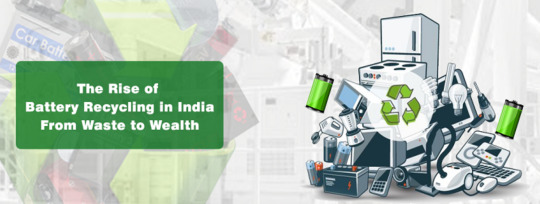
In the age of technology, where batteries power everything from our smartphones to our cars, the importance of battery recycling cannot be overstated. As India stands on the verge of an energy revolution, recycling has emerged as a critical component of the country’s sustainable future.
Recycling batteries is the process of converting used batteries into reusable materials, thereby reducing the need for new raw materials and the environmental impact of waste disposal. It’s a practice that not only conserves resources but also prevents old batteries, which can be toxic and made economically useful, instead of ending them in landfill sites.
India, with its huge population and rapidly growing economy, generates a significant amount of battery waste. The rise of electric vehicles and renewable energy storage solutions has further amplified the need for effective battery recycling. Recognizing this, the Indian government has implemented policies and regulations to encourage the proper disposal and recycling of batteries.
The Need for Recycling Batteries
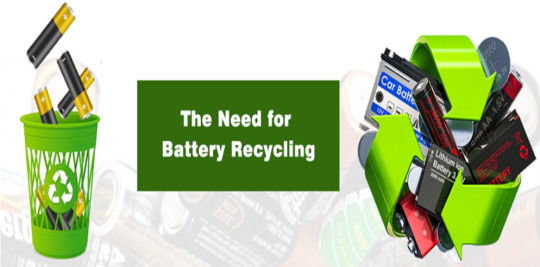
Recycling Batteries is not just a matter of environmental responsibility; it’s a necessity. The improper disposal of batteries can have severe environmental and economic implications.
Environmental Impact of Improper Battery Disposal
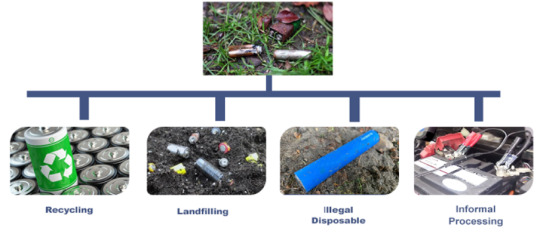
Batteries contain a variety of heavy metals and toxic chemicals, including lead, mercury, cadmium, and lithium. When disposed of improperly, these substances can leak into the soil and water, causing significant environmental harm. This contamination can disrupt ecosystems, harm wildlife, and even pose risks to human health through the contamination of food and water supplies.
Moreover, the improper disposal of batteries contributes to the growing problem of electronic waste, or e-waste. E-waste is one of the fastest-growing waste streams globally, posing a significant challenge for waste management and leading to the loss of valuable resources that could be recovered and reused.
Economic Benefits of Battery Recycling

On the other side, recycling batteries offers substantial economic benefits. The process of recycling recovers valuable materials like lead, nickel, and lithium, which can be reused to manufacture new batteries or other products. This reduces the demand for new and unused materials, leading to cost savings and a lower environmental footprint.
In addition, the battery recycling industry can create jobs and stimulate economic growth. As the demand for batteries continues to rise, particularly with the growth of electric vehicles and renewable energy storage, so does the potential for a thriving battery recycling industry.
In India, the battery recycling sector is still in its infant stages, but it holds immense potential. With the right policies and infrastructure, battery recycling can become a significant industry, contributing to India’s economy while helping to address environmental challenges.
The journey of recycling batteries in India can be a fascinating tale of turning waste into wealth. It can build a story of how a country can leverage policy, technology, and entrepreneurship to transform a challenge into an opportunity.
Indian Government’s Policy on Battery Recycling
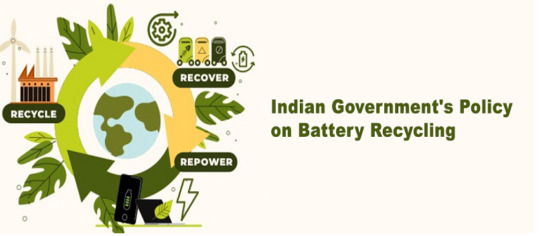
Recognizing the importance of recycling batteries, the Indian government has implemented a series of policies and regulations aimed at promoting responsible battery disposal and recycling.
Overview of the Battery Waste Management Rules 2022
Battery Waste Management Rules 2022 replaces the earlier Battery Management and Handling Rules 2001, providing a unified structure for the management of battery waste in India. They cover all types of batteries and apply to manufacturers, importers, assemblers, re-conditioners, consumers, and recyclers.
The 2022 rules introduce several significant changes, including stricter Extended Producer Responsibility (EPR) obligations, a focus on environmentally sound management of battery waste, and provisions for the formalization of the informal battery recycling sector.
Role of Extended Producer Responsibility (EPR)

Extended Producer Responsibility (EPR) is a policy approach under which producers are given significant responsibility for the treatment or disposal of post-consumer products.
Under the Battery Waste Management Rules 2022, producers are required to ensure that used batteries are collected and sent for recycling in an environmentally sound manner. They are also required to create awareness among consumers about the importance of proper battery disposal.
Government’s Initiatives to Promote Battery Recycling
The Indian government has launched several awareness campaigns, incentives for battery recycling businesses, and research and development programs to improve battery recycling technologies.
Furthermore, the government is also working to strengthen the infrastructure for battery collection and recycling and to formalize the informal battery recycling sector, which currently handles a significant portion of battery waste in India.
The Process of Recycling Batteries
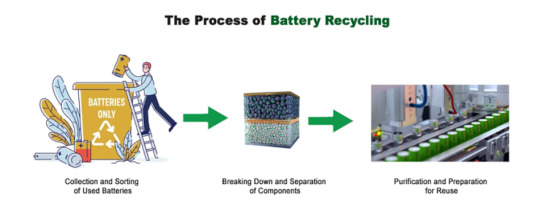
Recycling Batteries is a complex process that involves several stages, each of which plays a crucial role in transforming used batteries into reusable materials. Here’s a closer look at how it works:
Collection and Sorting of Used Batteries
The first step in the recycling process is the collection of used batteries. This can be done through various means, including collection boxes at retail stores, community recycling events, and dedicated battery recycling facilities.
Once the batteries are collected, they are sorted based on their chemistry. Different types of batteries such as lead-acid, nickel-cadmium, and lithium-ion require different recycling processes, so accurate sorting is crucial.
Breaking Down and Separation of Components
After sorting, the batteries are broken down, often through a process called mechanical treatment. This involves crushing the batteries into small pieces, which makes it easier to separate the different components.
The crushed batteries are then separated into different streams. For example, in the case of lead-acid batteries, the lead and plastic components are separated from the electrolyte.
Purification and Preparation for Reuse
The separated materials then undergo further treatment to purify them and prepare them for reuse. This can involve a variety of processes, depending on the type of material.
For example, lead from lead-acid batteries is often smelted and refined to remove impurities, after which it can be used to manufacture new batteries. Similarly, plastic components can be cleaned and converted into pellets for use in new plastic products.
The recycling process not only recovers valuable materials from used batteries but also ensures that potentially harmful substances are managed in an environmentally sound manner.
The Business of Battery Recycling in India

Current State of Battery Recycling Industry in India
As the demand for batteries continues to grow, so does the potential for a thriving battery recycling industry. The Industry of recycling batteries in India is still in its infancy stages, but it’s growing rapidly.
Currently, the industry is dominated by the unorganized sector, which handles a significant portion of battery waste. However, as the market grows, more and more companies will enter the market and invest in advanced recycling technologies.
Major Companies Involved in Recycling Batteries
Several companies are leading the way in recycling batteries in India. These include Gravita India Ltd., a leading lead recycling company, and Attero Recycling, which specialises in e-waste management and recycles various types of batteries. Other players include Ecoreco, which offers solutions for e-waste and battery waste management, and Exigo Recycling, which provides recycling services for electronic waste, including batteries.
Opportunities and Challenges in the Battery Recycling Business
Read the full article at: https://dsb.edu.in/the-rise-of-battery-recycling-in-india-from-waste-to-wealth/?utm_source=tumblr&utm_medium=tumblr&utm_campaign=tumblr+battery+recycling
#waste management#battery#recycling#battery recycling market trend#battery recycling#ai#india#blockchain#fintech#jobs#education#google
0 notes
Text
वंदे भारत ई-रिक्शा (Vande Bharat e Rickshaw): Price। Range। Features। Specification
vande bharat e rickshaw, वंदे भारत ई-रिक्शा, e rickshaw, e rickshaw price, e rickshaw market in delhi, e rickshaw price in delhi, second hand e rickshaw in delhi, e rickshaw business in hindi, second hand e rickshaw price in delhi, e rickshaw drivers in delhi, e rickshaw price in india, electric rickshaw, e rikshaw in under 1 lack, e rikshaw in 60000, loading e rikshaw in 60000, best e rickshaw…

View On WordPress
#battery rickshaw#best e rickshaw battery in india#e rickshaw#e rickshaw business in hindi#e rickshaw drivers in delhi#e rickshaw market in delhi#e rickshaw price#e rickshaw price in delhi#e rickshaw price in india#e rickshaw&039;s in delhi#e rikshaw in 60000#e rikshaw in under 1 lack#electric rickshaw#loading e rikshaw in 60000#rickshaw#second hand e rickshaw in delhi#second hand e rickshaw price in delhi#vande bharat e rickshaw#वंदे भारत ई-रिक्शा
0 notes
Text
Vivo S17t लॉन्च: 50MP कैमरा और 12GB रैम के साथ मिलेंगी बेहतरीन फीचर्स, जानें कीमत और स्पेसिफिकेशन्स
Vivo S17t के 50MP कैमरा और 12GB रैम क्या आपको बेस्ट मोबाइल एक्सपीरियंस देंगे? जानिए कीमत, स्पेसिफिकेशन्स और एक्सक्लूसिव फीचर्स इस रिव्यू में। अब क्लिक करें!
HIGHLIGHTS
विवो S17t अब चीन के बाजार में खरीदने के लिए उपस्थित है।
डिवाइस में 12GB RAM और 512GB इंटरनल स्टोरेज का संयोजन मिलता है।
Dimensity 8050 चिपसेट के साथ यह स्मार्टफोन उत्कृष्ट प्रदर्शन प्रदान करता है।
Vivo ने साल की शुरुवात में…

View On WordPress
#120Hz Refresh Rate#12GB RAM#4600mAh Battery#50MP Camera#512GB Storage#5G Support#80W Fast Charging#AMOLED Display#Android 13#Bluetooth 5.2#Chinese Market#Dimensity 8050#Hindi Article#Hindi Jankari#hindi mobile specifications#hindi news#K.G.N Digital#LPDDR4x#NFC#Price in India#Tech news in hindi#UFS 3.1#Vivo S17t#vivo s17t review in hindi#Vivo Smartphone#Wi-Fi 6
0 notes
Text
Solar Powered Outdoor Lights Market Analytical Overview and Growth Opportunities by 2032
The solar-powered outdoor lights market has been experiencing significant growth due to increasing environmental awareness and the growing adoption of sustainable energy solutions. Solar-powered outdoor lights utilize solar panels to convert sunlight into electricity, eliminating the need for traditional power sources. These lights are widely used for outdoor illumination in residential, commercial, and industrial settings.
Analysis:
The solar-powered outdoor lights market is expected to witness robust growth during the forecast period, driven by the increasing demand for sustainable lighting solutions.
North America and Europe are anticipated to dominate the market due to stringent regulations promoting renewable energy adoption.
Asia Pacific region is expected to experience significant growth, supported by rapid urbanization and government initiatives in countries like China and India.
Technological advancements, such as improved solar panel efficiency and battery storage capabilities, are expected to drive market growth.
Key challenges include the high upfront cost of solar-powered outdoor lights and the limited availability of sunlight in certain regions. However, declining solar panel costs and advancements in battery technology are mitigating these challenges.
Growth Opportunities:
Increasing government initiatives promoting renewable energy and energy-efficient lighting solutions.
Growing demand for smart solar-powered outdoor lights integrated with advanced technologies like motion sensors and remote control capabilities.
Rapid urbanization and infrastructure development in emerging economies, driving the need for reliable and sustainable lighting solutions.
Rising consumer awareness about the benefits of solar energy and the need to reduce carbon footprints.
Technological advancements leading to improved efficiency, longer battery life, and enhanced aesthetics of solar-powered outdoor lights.
Key Points:
Solar-powered outdoor lights offer significant cost savings over traditional lighting solutions, as they eliminate electricity bills and reduce maintenance costs.
These lights are environmentally friendly, as they do not emit harmful greenhouse gases and reduce reliance on fossil fuels.
Solar-powered outdoor lights provide reliable illumination even in remote areas without access to electricity grids.
The market is witnessing increased collaborations and partnerships among key vendors to expand their product portfolios and geographical presence.
The integration of solar-powered outdoor lights with smart home systems and IoT technologies is opening up new opportunities for market growth.
We recommend referring our Stringent datalytics firm, industry publications, and websites that specialize in providing market reports. These sources often offer comprehensive analysis, market trends, growth forecasts, competitive landscape, and other valuable insights into this market.
By visiting our website or contacting us directly, you can explore the availability of specific reports related to this market. These reports often require a purchase or subscription, but we provide comprehensive and in-depth information that can be valuable for businesses, investors, and individuals interested in this market.
“Remember to look for recent reports to ensure you have the most current and relevant information.”
Click Here, To Get Free Sample Report: https://stringentdatalytics.com/sample-request/solar-powered-outdoor-lights-market/6229/
Market Segmentations:
Global Solar Powered Outdoor Lights Market: By Company
• Greenshine New Energy
• SBM-SolarTech
• Signify Holding
• Jiawei
• LEADSUN
• OkSolar
• SEPCO Solar Electric Power Company
• SOKOYO
• Solar Street Lights USA
• Sunna Design SA
Global Solar Powered Outdoor Lights Market: By Type
• Less than 39W
• 40W to 149W
• More than 150W
Global Solar Powered Outdoor Lights Market: By Application
• Residential
• Commercial
• Industrial
• Goverment
Global Solar Powered Outdoor Lights Market: Regional Analysis
All the regional segmentation has been studied based on recent and future trends, and the market is forecasted throughout the prediction period. The countries covered in the regional analysis of the Global Solar Powered Outdoor Lights market report are U.S., Canada, and Mexico in North America, Germany, France, U.K., Russia, Italy, Spain, Turkey, Netherlands, Switzerland, Belgium, and Rest of Europe in Europe, Singapore, Malaysia, Australia, Thailand, Indonesia, Philippines, China, Japan, India, South Korea, Rest of Asia-Pacific (APAC) in the Asia-Pacific (APAC), Saudi Arabia, U.A.E, South Africa, Egypt, Israel, Rest of Middle East and Africa (MEA) as a part of Middle East and Africa (MEA), and Argentina, Brazil, and Rest of South America as part of South America.
Visit Report Page for More Details: https://stringentdatalytics.com/reports/solar-powered-outdoor-lights-market/6229/
Reasons to Purchase Solar Powered Outdoor Lights Market Report:
• To obtain insights into industry trends and dynamics, including market size, growth rates, and important factors and difficulties. This study offers insightful information on these topics.
• To identify important participants and rivals: This research studies can assist companies in identifying key participants and rivals in their sector, along with their market share, business plans, and strengths and weaknesses.
• To comprehend consumer behaviour: these research studies can offer insightful information about customer behaviour, including preferences, spending patterns, and demographics.
• To assess market opportunities: These research studies can aid companies in assessing market chances, such as prospective new goods or services, fresh markets, and new trends.
• To make well-informed business decisions: These research reports give companies data-driven insights that they may use to plan their strategy, develop new products, and devise marketing and advertising plans.
In general, market research studies offer companies and organisations useful data that can aid in making decisions and maintaining competitiveness in their industry. They can offer a strong basis for decision-making, strategy formulation, and company planning.
About US:
Stringent Datalytics offers both custom and syndicated market research reports. Custom market research reports are tailored to a specific client's needs and requirements. These reports provide unique insights into a particular industry or market segment and can help businesses make informed decisions about their strategies and operations.
Syndicated market research reports, on the other hand, are pre-existing reports that are available for purchase by multiple clients. These reports are often produced on a regular basis, such as annually or quarterly, and cover a broad range of industries and market segments. Syndicated reports provide clients with insights into industry trends, market sizes, and competitive landscapes. By offering both custom and syndicated reports, Stringent Datalytics can provide clients with a range of market research solutions that can be customized to their specific needs
Contact US:
Stringent Datalytics
Contact No - +1 346 666 6655
Email Id - [email protected]
Web - https://stringentdatalytics.com/
#Solar Powered Outdoor Lights Market Analytical Overview and Growth Opportunities by 2032#The solar-powered outdoor lights market has been experiencing significant growth due to increasing environmental awareness and the growing#eliminating the need for traditional power sources. These lights are widely used for outdoor illumination in residential#commercial#and industrial settings.#Analysis:#•#The solar-powered outdoor lights market is expected to witness robust growth during the forecast period#driven by the increasing demand for sustainable lighting solutions.#North America and Europe are anticipated to dominate the market due to stringent regulations promoting renewable energy adoption.#Asia Pacific region is expected to experience significant growth#supported by rapid urbanization and government initiatives in countries like China and India.#Technological advancements#such as improved solar panel efficiency and battery storage capabilities#are expected to drive market growth.#Key challenges include the high upfront cost of solar-powered outdoor lights and the limited availability of sunlight in certain regions. H#declining solar panel costs and advancements in battery technology are mitigating these challenges.#Growth Opportunities:#Increasing government initiatives promoting renewable energy and energy-efficient lighting solutions.#Growing demand for smart solar-powered outdoor lights integrated with advanced technologies like motion sensors and remote control capabili#Rapid urbanization and infrastructure development in emerging economies#driving the need for reliable and sustainable lighting solutions.#Rising consumer awareness about the benefits of solar energy and the need to reduce carbon footprints.#Technological advancements leading to improved efficiency#longer battery life#and enhanced aesthetics of solar-powered outdoor lights.#Key Points:#1.#Solar-powered outdoor lights offer significant cost savings over traditional lighting solutions#as they eliminate electricity bills and reduce maintenance costs.
0 notes